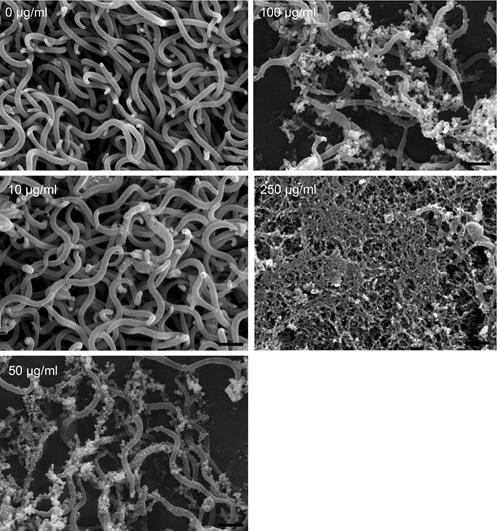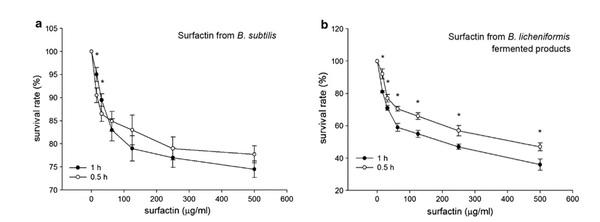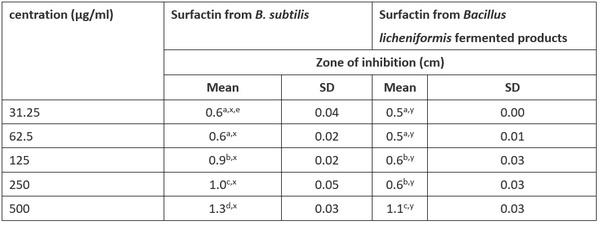
Content sponsored by:
Life Rainbow
Antibacterial activity of Bacillus species-derived surfactin on Brachyspira hyodysenteriae and Clostridium perfringens (Extract)
Published: February 3, 2022
By: Life Rainbow
Swine dysentery (SD) caused by Brachyspira hyodysenteriae is a highly contagious disease of grower and finisher pigs. SD causes severe mucohemorrhagic diarrhea, resulting in decreased feed efficiency and increased morbidity. Necrotic enteritis (NE) caused by Clostridium perfringens is characterized by high mortality in poultry with bloody diarrhea, and sudden death.
B. subtilis and B. licheniformis have been identified from the gastrointestinal tract of broilers with antimicrobial activity. Furthermore, it has been demonstrated that Bacillus species are able to produce a variety of antimicrobial peptides. The surfactin, Bacillus-derived cyclic lipopeptide, is an important antimicrobial peptide with antibacterial activity through disruption of the bacterial membrane. In the present study, we investigated the antibacterial activity of Bacillus species-derived surfactin on B. hyodysenteriae and C. perfringens.
Antibacterial activity of Bacillus species-derived surfactin on B. hyodysenteriae
Results of confocal microscopy examinations showed that B. subtilis-derived surfactin is able to cause the death of B. hyodysenteriae in a dose dependent manner (Fig. 1a). A longer duration (1 h) of B. subtilis-derived surfactin treatment could increase the death rate of B. hyodysenteriae (P < 0.05, Fig. 1a). Similarly, the surfactin from B. licheniformis fermented products also caused the death of B. hyodysenteriae in a dose dependent manner (Fig. 1b). Duration of treatment of B. licheniformis-derived surfactin did not affect the death rate of B. hyodysenteriae except with 9.31 μg/ml treatment (Fig. 1b). Relative to the surfactin from B. licheniformis fermented products, B. subtilis-derived surfactin had the highest antibacterial activity against B. hyodysenteria (Fig. 1a, b). Results of agar-well diffusion assay revealed that B. subtilis-derived surfactin exhibited a significant inhibition zone compared with B. licheniformis fermented product-derived surfactin (Fig. 2). The results of quantification of the inhibition zone are presented in Table 1. Results showed that the B. subtilis-derived surfactin caused the inhibition of B. hyodysenteriae growth in a dose dependent manner (P < 0.05). Similarly, B. licheniformis fermented products also had a dose dependent inhibitory effect on B. hyodysenteriae growth (P < 0.05). The zone of inhibition of B. subtilis-derived surfactin on B. hyodysenteriae growth was greater than B. licheniformis fermented products-derived surfactin (P < 0.05). Furthermore, results of scanning electron microscopy showed that B. subtilis-derived surfactin could disrupt the morphology of B. hyodysenteriae in a dose dependent manner after 1 h treatment compared with the untreated group (Fig. 3).

Fig. 1 Killing activity of surfactin against B. hyodysenteriae. a B. hyodysenteriae were incubated with different concentrations (9.31, 18.63, 37.25, 62.5, 125, 250, 500 μg/ml) of the B. subtilis-derived surfactin for 0.5 and 1 h. b B. hyodysenteriae were incubated with different concentrations (9.31, 18.63, 37.25, 62.5, 125, 250, 500 μg/ml) of the B. licheniformis-fermented product-derived surfactin for 0.5 and 1 h. The error bars represent the mean ± standard deviations from triplicate assays (n = 3). *P < 0.05 comparing data of 0.5 h versus 1 h.

Fig. 2 Growth inhibitory zone of surfactin against B. hyodysenteriae using agar-well diffusion assay. B. hyodysenteriae were grown in the different concentrations (50, 100, 250, 500 μg/ml) of surfactin produced from B. subtilis (left) and B. licheniformis-fermented products (right) for 24 h. The black arrow indicates inhibition zone. Three experiments were conducted, and one representative result is presented.
Table 1 Measurement of zone of inhibition of surfactin on B. hyodysenteriae growth at different concentrations

a–cMeans within a column with no common superscript are significantly different (P < 0.05)
x–yMeans within a row with no common superscript are significantly different (P < 0.05)
dValues are expressed as mean ± SD (n = 3)

Fig. 3 Scanning electron microscope images of B. hyodysenteriae illustrating the antibacterial activity of different concentrations (10, 50, 100, 250 μg/ml) of the commercial surfactin after incubating for 1 h. Three experiments were conducted, and one representative result is presented
Antibacterial activity of Bacillus species-derived surfactin on C. perfringens
Results of confocal microscopy examinations showed that B. subtilis-derived surfactin is able to cause the death of C. perfringens in a dose dependent manner (Fig. 4a). A longer duration (1 h) of B. subtilis-derived surfactin treatment could increase the death rate of C. perfringens except at 7.8 and 15.62 μg/ml (P < 0.05, Fig. 4a). The surfactin from B. licheniformis fermented products also caused the death rate of C. perfringens to increase in a dose dependent manner (Fig. 4b). Similarly, a longer (1 h) duration of B. licheniformis fermented product-derived surfactin treatment could increase the death of C. perfringens (P < 0.05, Fig. 4b). Relative to B. subtilis-derived surfactin, surfactin from B. licheniformis fermented products had the highest antibacterial activity against C. perfringens (Fig. 4a, b). Results of agar-well diffusion assay showed that B. subtilis-derived surfactin exhibited a significant inhibition zone (250 μg/ml and 500 μg/ml) compared with B. licheniformis fermented product-derived surfactin (Fig. 5). The results of quantification of the inhibition zone are presented in Table 2. Results showed that B. subtilis-derived surfactin caused the inhibition of C. perfringens growth in a dose dependent manner (P < 0.05). Similarly, B. licheniformis fermented product-derived surfactin also had a dose dependent inhibitory effect on C. perfringens growth (P < 0.05). In addition, the zone of inhibition of B. subtilis-derived surfactin on C. perfringens growth was greater than B. licheniformis fermented product-derived surfactin (P < 0.05).

Fig. 4 Killing activity of surfactin against C. perfringens. a C. perfringens were incubated with different concentrations (7.8, 15.62, 31.25, 62.5, 125, 250, 500 μg/ml) of the B. subtilis-derived surfactin for 0.5 and 1 h. b C. perfringens were incubated with different concentrations (7.8, 15.62, 31.25, 62.5, 125, 250, 500 μg/ml) of the B. licheniformis-fermented products-derived surfactin for 0.5 and 1 h. The error bars represent the mean ± standard deviations from triplicate assays (n = 3). *P < 0.05 comparing data of 0.5 h versus 1 h

Fig. 5 Growth inhibitory zone of surfactin against C. perfringens using agar-well diffusion assay. C. perfringens were grown in the different concentrations (50, 100, 250, 500 μg/ml) of the surfactin produced from B. subtilis (top left) and B. licheniformis-fermented products (bottom left), blank (top right), and ampicillin (bottom right) for 24 h. The black arrow indicates the inhibition zone. Three experiments were conducted, and one representative result is presented.
Table 2 Measurement of zone of inhibition of surfactin on C. perfringens growth at different concentrations

In conclusion, this paper provides evidence that surfactin has antibacterial activity against B. hyodysenteriae and C. perfringens. The surfactin produced from B. subtilis have the highest activity against B. hyodysenteriae and C. perfringens growth. The B. subtilis-derived surfactin exhibited better bacterial killing activity against B. hyodysenteriae. In contrast, B. licheniformis fermented product-derived surfactin showed stronger bacterial killing activity against C. perfringens.
References
Horng Y. B., Y. H. Yu, A. Dybus, F. S. H. Hsiao, Y. H. Cheng. Antibacterial activity of Bacillus species-derived surfactin on Brachyspira hyodysenteriae and Clostridium perfringens. AMB Express 2019, 9, 188
Related topics:
Recommend
Comment
Share

Would you like to discuss another topic? Create a new post to engage with experts in the community.